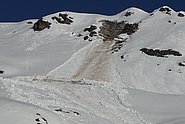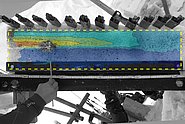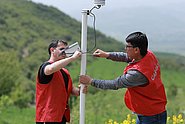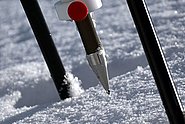
Snow as a material ¶
Hot and cold, hard and soft, white and black – snow is a material of contradictions. It is constantly changing, which means that its properties also change very quickly. To understand these complex processes, we start by examining the smallest level: the microstructure of snow.
Snow occurs when supercooled water droplets in clouds solidify to form ice, and then water vapour deposits on these crystallised nuclei and freezes. The shape of the crystals varies from needles to the familiar stars, depending on the ambient conditions, but all have a hexagonal structure. However, each snow crystal is unique. Measuring just a millimetre in diameter, a single ice crystal contains around 100 trillion water molecules, so the probability that two crystals are identically constructed, i.e. that all molecules are located in the same place, is very small.
When crystals accumulate on the ground during snowfall, they form a complex material. This initially is mostly soft and loose, but within a short time the ice crystals merge at their points of contact in a process known as 'sintering'. This results in a coherent porous structure, similar to a sponge made of ice. However, this structure soon alters. Because snow is so close to its melting temperature (making it a 'hot' material in physical terms), it changes constantly. This alteration is known as metamorphism.
As the structure changes, so too do the material properties of the snow, such as its density. Whereas a cubic metre of fresh snow contains so much air that it weighs just 50-100 kilograms, the same amount of older, sintered snow can weigh up to 400 kilograms.
Microstructure – the key to understanding ¶
In the spectrum of light visible to the human eye, snow is almost perfectly white as it scatters all wavelengths equally. By contrast, snow absorbs almost all thermal radiation, making it a 'black body' for those wavelengths.
To understand the properties of snow, we must begin with its microstructure. Its physical properties, such as strength or thermal conductivity, depend on the structure of the sponge-like network in which the ice crystals are arranged. We investigate this three-dimensional structure in a cold laboratory using computed tomography. In nature, the various factors that act simultaneously on snow are usually hard to distinguish. In the lab, however, we can examine individual aspects in isolation, giving us a step-by-step insight into how snow changes under different influences. In experiments we determine the mechanical and optical properties of different types of snow. We either collect this snow from the natural environment or create nature-identical new snow in the laboratory using the SnowMaker.






